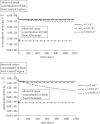Low dose ionizing radiation produces too few reactive oxygen species to directly affect antioxidant concentrations in cells - PubMed (original) (raw)
Low dose ionizing radiation produces too few reactive oxygen species to directly affect antioxidant concentrations in cells
J T Smith et al. Biol Lett. 2012.
Abstract
It has been hypothesized that radiation-induced oxidative stress is the mechanism for a wide range of negative impacts on biota living in radioactively contaminated areas around Chernobyl. The present study tests this hypothesis mechanistically, for the first time, by modelling the impacts of radiolysis products within the cell resulting from radiations (low linear energy transfer β and γ), and dose rates appropriate to current contamination types and densities in the Chernobyl exclusion zone and at Fukushima. At 417 µGy h(-1) (illustrative of the most contaminated areas at Chernobyl), generation of radiolysis products did not significantly impact cellular concentrations of reactive oxygen species, or cellular redox potential. This study does not support the hypothesis that direct oxidizing stress is a mechanism for damage to organisms exposed to chronic radiation at dose rates typical of contaminated environments.
Figures
Figure 1.
Changes in (a) _α_-tocopherol and (b) carotenoids in birds' liver as a result of 417 µGy h−1 ionizing radiation (many times higher than the mean at the Chernobyl study sites; see electronic supplementary material). (Anti-oxidant concentrations were estimated from Møller et al. [4].)
Figure 2.
Predicted changes in glutathione (GSH) concentration (dashed line) and cellular redox potential (_E_h) following 1200 day exposure to 10 mGy d−1 (417 µGy h−1) ionizing radiation assuming initial 1 mM total (GSH + GSSG) and an unrealistically slow glutathione replenishment rate of 0.001 d−1. Solid line, _E_h (mV).
Similar articles
- Increased oxidative stress in barn swallows from the Chernobyl region.
Bonisoli-Alquati A, Mousseau TA, Møller AP, Caprioli M, Saino N. Bonisoli-Alquati A, et al. Comp Biochem Physiol A Mol Integr Physiol. 2010 Feb;155(2):205-10. doi: 10.1016/j.cbpa.2009.10.041. Epub 2009 Nov 5. Comp Biochem Physiol A Mol Integr Physiol. 2010. PMID: 19896553 - Antioxidants in eggs of great tits Parus major from Chernobyl and hatching success.
Møller AP, Karadas F, Mousseau TA. Møller AP, et al. J Comp Physiol B. 2008 Aug;178(6):735-43. doi: 10.1007/s00360-008-0262-z. Epub 2008 Apr 8. J Comp Physiol B. 2008. PMID: 18392836 - Carotenoid distribution in wild Japanese tree frogs (Hyla japonica) exposed to ionizing radiation in Fukushima.
Giraudeau M, Bonzom JM, Ducatez S, Beaugelin-Seiller K, Deviche P, Lengagne T, Cavalie I, Camilleri V, Adam-Guillermin C, McGraw KJ. Giraudeau M, et al. Sci Rep. 2018 May 9;8(1):7438. doi: 10.1038/s41598-018-25495-5. Sci Rep. 2018. PMID: 29743616 Free PMC article. - Adaptation to ionizing radiation of higher plants: From environmental radioactivity to chernobyl disaster.
Ludovici GM, Oliveira de Souza S, Chierici A, Cascone MG, d'Errico F, Malizia A. Ludovici GM, et al. J Environ Radioact. 2020 Oct;222:106375. doi: 10.1016/j.jenvrad.2020.106375. Epub 2020 Aug 10. J Environ Radioact. 2020. PMID: 32791372 Review. - Ionizing radiation-induced metabolic oxidative stress and prolonged cell injury.
Azzam EI, Jay-Gerin JP, Pain D. Azzam EI, et al. Cancer Lett. 2012 Dec 31;327(1-2):48-60. doi: 10.1016/j.canlet.2011.12.012. Epub 2011 Dec 17. Cancer Lett. 2012. PMID: 22182453 Free PMC article. Review.
Cited by
- Radiation takes its Toll.
Ratikan JA, Micewicz ED, Xie MW, Schaue D. Ratikan JA, et al. Cancer Lett. 2015 Nov 28;368(2):238-45. doi: 10.1016/j.canlet.2015.03.031. Epub 2015 Mar 25. Cancer Lett. 2015. PMID: 25819030 Free PMC article. Review. - Preventive or potential therapeutic value of nutraceuticals against ionizing radiation-induced oxidative stress in exposed subjects and frequent fliers.
Giardi MT, Touloupakis E, Bertolotto D, Mascetti G. Giardi MT, et al. Int J Mol Sci. 2013 Aug 20;14(8):17168-92. doi: 10.3390/ijms140817168. Int J Mol Sci. 2013. PMID: 23965979 Free PMC article. Review. - [The effect of low dose ionizing radiation exposure on dynamic thiol-disulfide homeostasis and ischemia modified albumin levels: an observational study].
Arıcan S, Dertli R, Baktik S, Hacibeyoglu G, Erol A, Ulukaya SO, Goger E, Erel Ö. Arıcan S, et al. Braz J Anesthesiol. 2020 May-Jun;70(3):233-239. doi: 10.1016/j.bjan.2020.02.009. Epub 2020 May 13. Braz J Anesthesiol. 2020. PMID: 32482354 Free PMC article. - Targeted Central Nervous System Irradiation with Proton Microbeam Induces Mitochondrial Changes in Caenorhabditis elegans.
Sleiman A, Lalanne K, Vianna F, Perrot Y, Richaud M, SenGupta T, Cardot-Martin M, Pedini P, Picard C, Nilsen H, Galas S, Adam-Guillermin C. Sleiman A, et al. Biology (Basel). 2023 Jun 9;12(6):839. doi: 10.3390/biology12060839. Biology (Basel). 2023. PMID: 37372124 Free PMC article. - First transcriptome profiling of D. melanogaster after development in a deep underground low radiation background laboratory.
Zarubin M, Gangapshev A, Gavriljuk Y, Kazalov V, Kravchenko E. Zarubin M, et al. PLoS One. 2021 Aug 5;16(8):e0255066. doi: 10.1371/journal.pone.0255066. eCollection 2021. PLoS One. 2021. PMID: 34351964 Free PMC article.
References
- Monaghan P., Metcalfe N. B., Torres R. 2009. Oxidative stress as a mediator of life history trade-offs: mechanisms, measurements and interpretation. Ecol. Lett. 12, 75–9210.1111/j.1461-0248.2008.01258.x (doi:10.1111/j.1461-0248.2008.01258.x) - DOI - DOI - PubMed
- Weiss J. F., Landauer M. R. 2003. Protection against ionizing radiation by antioxidant nutrients and phytochemicals. Toxicology 189, 1–2010.1016/S0300-483X(03)00149-5 (doi:10.1016/S0300-483X(03)00149-5) - DOI - DOI - PubMed
- Esnault M.-A., Legue F., Chenal C. 2010. Ionizing radiation: advances in plant response. Environ. Exp. Bot. 68, 231–23710.1016/j.envexpbot.2010.01.007 (doi:10.1016/j.envexpbot.2010.01.007) - DOI - DOI
- Møller A. P., Surai P., Mousseau T. A. 2005. Antioxidants, radiation and mutation as revealed by sperm abnormality in barn swallows from Chernobyl. Proc. R. Soc. B 272, 247–25310.1098/rspb.2004.2914 (doi:10.1098/rspb.2004.2914) - DOI - DOI - PMC - PubMed
- Zaka R., Vandecasteele C. M., Misset M. T. 2002. Effects of low chronic doses of ionizing radiation on antioxidant enzymes and G6PDH activities in Stipa capillata (Poaceae). J. Exp. Bot. 53, 1979–198710.1093/jxb/erf041 (doi:10.1093/jxb/erf041) - DOI - DOI - PubMed
MeSH terms
Substances
LinkOut - more resources
Full Text Sources
Medical

